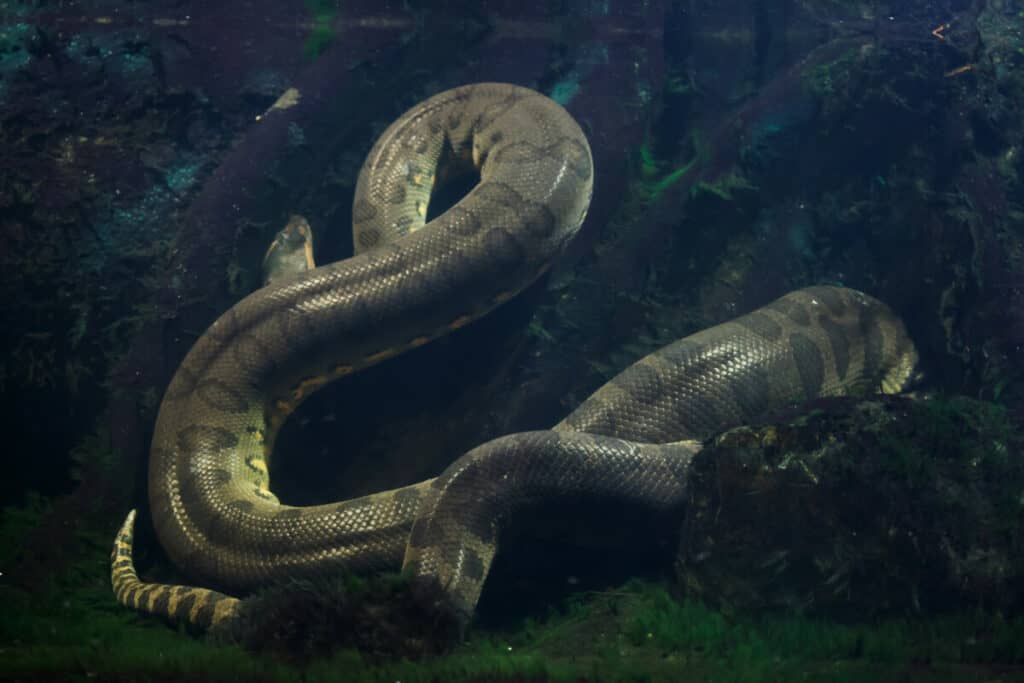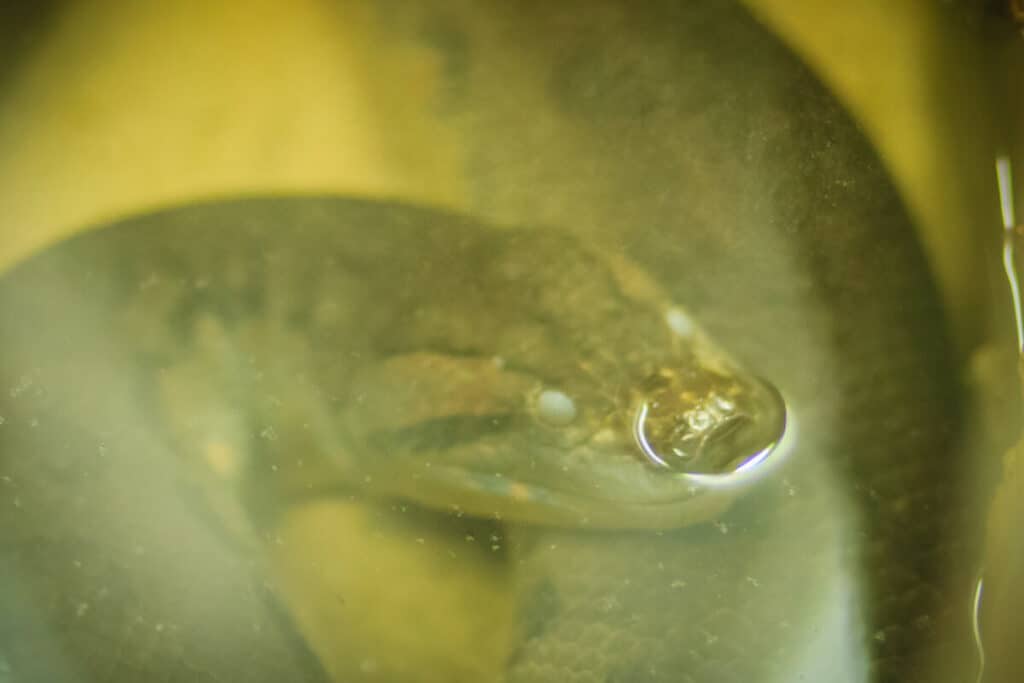
Anacondas are a type of boa that live almost entirely in or around water. These hefty snakes use their swimming skills to the best of their abilities, ambushing smaller animals, and even other reptiles on occasion, and holding them underwater until they drown. This may make you wonder if anacondas can breathe underwater?
Anacondas cannot breathe underwater but they can hold their breath underwater for up to 10 minutes. Anacondas breathe through nostrils situated on top of their skulls, oriented so they can breathe with only their head showing above the surface of the water as they wait for prey.
As air-breathing creatures, why then do anacondas spend such a great portion of their time surrounded by water? The answer is simple: the element of surprise. These apex predators use their skills in navigating waters to sneak up on unsuspecting prey.
Anacondas Love To Live Near Water
There are four types of anacondas. The most common of these is the green anaconda (Eunectes murinus), native to northern South America, and abundant in Colombia’s Orinoco Basin and Brazil’s Amazon River. The other types include the yellow anaconda (Eunectes notaeus), characterized by (no surprise here) its yellow pigmentation, the dark-spotted anaconda (Eunectes deschauenseei), and the least common Beni or Bolivian anaconda (Eunectes beniensis).
Because most of their lives are spent in the water, anacondas are sometimes known to be referred to as “water boas.” The name of the anaconda’s genus, Eunectes is derived from the Greek word Eυνήκτης, meaning “good swimmer.” Though they spend most of their time in the water but can also be found on land in places with thick vegetation, often hanging out in trees. During drier seasons some anacondas seek to burrow into thick mud to keep themselves moist, or else will leave the area to find a source of water.
Anacondas make their homes in the wetlands, swamps, and rivers of central South America, east of the Andes mountains. Some species of anaconda can be found as far south as northern Argentina, and cover a large portion of the continent including Peru, Ecuador, Bolivia, and other countries.
How Long Can An Anaconda Hold Its Breath Underwater?

Though most of their time is spent in or around the water, anacondas do not have the ability to breathe underwater. Instead, they subsist by holding their breath for long periods of time when they are required to be underwater, similarly to how hippos and alligators hold their breath. A fully grown anaconda — which can grow to reach about 30 feet in length and 12 inches in diameter, and frequently weigh around 200 pounds — can hold its breath for around 10 minutes.
The anatomical structure of the anaconda further aids its maneuverability in the water. As the anaconda floats atop the water with just its snout poking above the surface, the snake becomes much more difficult to spot. Evolution has given these predators the hunting features of strategically positioned eyes and nostrils, both on top of the head, so that only a small part of the anaconda is visible, allowing the snake to breathe normally while mostly submerged in water.
Do not let the presence of nostrils confuse you, however. Anaconda nostrils only serve to provide the creature with air. Like other snakes, anacondas sense or “smell” chemical changes in the air around them with their tongues.
How do Anacondas Hunt?
With this nifty breathing hat trick, the anaconda does not need to breathe underwater, or even have venom like some other snakes do. It simply has to outlast whatever prey it captures. Taking its breath as it sneaks up on its prey, it springs from the water once in striking distance, wrestling its quarry into the water — where it has the advantage.
Anacondas do not simply rely on strangulation to kill their victims— generally anything smaller than the anaconda itself, which can include capybaras, fish, rodents, or other reptiles. Instead, the anaconda will wrestle its prey into submission, fighting until the weaker animal has used all its air and drowns before it can suffocate, all while the anaconda holds its breath.
Anacondas are opportunistic carnivores, meaning that they are not particularly picky about what they eat. Some of the most common meals for juvenile anacondas include birds, fish, and small mammals. For larger adult anacondas, mealtime stretches to consist of deer, caimans, and large birds. Females of the species, particularly during the breeding season, will occasionally cannibalize nearby males — which are much smaller and make for easier targets.
Generally, however, anacondas will settle for whatever smaller unsuspecting creature wanders near enough to its hiding place. They use their extreme size and weight in addition to their skill in swimming and holding their breath to crush their prey, unhinging their jaws to swallow the creature whole once it has been subdued in the water.
As larger prey takes a long time for an anaconda to digest, they may not eat for weeks or even months after an especially sizable kill. Instead, they continue to traverse their watery homes, waiting for the next time opportunity and hunger strikes.
Anacondas Spend A Lot Of Time Underwater
Though anacondas cannot breathe underwater, they do love using the water to their advantage. Since anacondas are great swimmers and can hold their breath underwater for up to 10 minutes, the water helps them become great hunters. An anaconda can drag its prey underwater and it will suffocate long before the anaconda even needs to think about taking its next breath.
Anacondas are typically always found near a body of water. They also often spend a good deal of their time underwater. So naturally, you might wonder if anacondas can actually breathe underwater. But being reptiles, they can not breathe underwater. Instead, they can simply hold their breath underwater much longer than most other animals.
